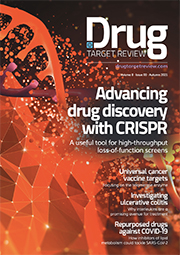How recent advances in flow cytometry can aid drug discovery
Posted: 7 September 2018 | Derek Davis - The Francis Crick Institute, Dr Rachael Walker - Babraham Institute | No comments yet
For many years, screening assays have been based on high-content imaging systems. However, recent advances in the field of flow cytometry have meant that flow-based assays are now more prevalent. The power of flow cytometry to utilise multiple lasers, multiple fluorochromes and multiplexed assays has meant that assays are not restricted to factors such as cell viability, proliferation and basic functional tests. In addition, the ability to interface with robotic staining and handling platforms and deal with a variety of plate formats means that flow cytometry is becoming an essential part of today’s drug discovery.


Flow cytometry is a powerful technique that can be used for the identification and separation of particles (usually cells) using fluorescence.1 Cells labelled with specific fluorescent antibodies and/or probes are individually passed in suspension through multiple laser beams to enable multiple measurements to be made on a cell-by-cell basis. This allows researchers to delve deeper into heterogeneous cell populations.
Flow cytometers are now commonplace in clinical, research and pharma labs, and are traditionally used for phenotyping, DNA analysis, pharmacokinetic and pharmacodynamic assays and cell sorting. In recent years we have seen the introduction of new fluorochromes and probes, the emergence of a generation of new fluorescent proteins, as well as the introduction of new laser excitation lines (deep UV eg, 325nm; Infrared eg, 800nm). These changes in technology have allowed scientists to examine more complex phenotyping and up to 28 fluorochromes may now be used on individual cells.2 In turn, these advances have made flow cytometry more appealing than the high-throughput assays currently used.
However, although flow cytometers can generate statistically robust data in multiple parameters, there have been some limitations when it comes to screening assays. These include speed of screening, issues of sample carryover, and the need for both reliability and reproducibility of results. This is all changing, however, with the introduction of several high-throughput cytometers that can couple with a robotic interface.
High-throughput assays
Traditionally, the vast majority of screening assays for drug discovery have been image-based. There are a number of well-established systems that can screen 96, 384 and 1536 well plates. In general, these use a set of well-established protocols but have limited complexity. Complexity is not necessarily needed in high-throughput systems, but it may be useful to have that capability should it be needed. Image-based systems have some advantages (easy to grow cells, ease of automation of staining, minimal cell loss during processing) but also some disadvantages (analysis – segmentation, edge effects, optical resolution).
Flow cytometry is a well-established technique in the biomedical arena and is suited both to simple assays (viability, fluorescent protein expression), as well as more complex phenotyping and functional assays (calcium flux, apoptosis etc). However, flow systems have not been so widely used, at least in the early stages of the discovery pipeline, because the majority of flow systems on the market do not operate at the required speed, offer little robotic interface capabilities, and require more intensive and careful staining. Many assays are better suited to suspension cells – either cells lines, iPS cells, or primary mouse or human blood.
The demands of the end-user, and the need to be adaptable, have meant that cytometer manufacturers have had to embrace the challenges of high-throughput systems, the miniaturisation of assays and the ability to interface with robotic handling for sample preparation and sample delivery to the cytometer.
High-throughput analysis is common in the pharmaceutical world and is becoming increasingly so in the research field. Typical assays include expression of fluorescent proteins, cell viability, cell cycle analysis, translocation assays, spot counting (eg, H2AX after DNA damage) and cell signalling. Screens can be based on genome-wide siRNA or RNAi analysis, or CRISPR assays for gain or loss of function. These assays are robust when results are either binary or are used on homogenous populations. However, the use of imaging in high-throughput or high-content analysis systems can be limiting in some cases. The cell number that can be acquired is limited (increasingly so as the plate format increases to 1536), analysis can be difficult if cells become too confluent, and the detection of rare events is limited by cell numbers.
Flow cytometry hardware, software and reagent changes in recent years
Hardware: Several flow cytometers on the market come with 96/384 well plate readers; however, it can take more than an hour to read a 96 well plate, depending on cell number and inter-well washes. This has significant limitations when it comes to screening assays. However, several instruments have been launched in recent years, which address the speed issues whilst still providing multi-parameter data with statistically robust data.
One such instrument is the 3 laser, 15 parameter Sartorius Intellicyt iQue Screener PLUS cytometer that was launched in 2015. As the big sister to their 2 laser, 6 parameter IQue system, this instrument has built on the capabilities of the IQue to provide scientists with more parameters without compromising speed. The IQue Plus marries speed with high-content analysis from up to 13 fluorescence markers and 2 scatter parameters, allowing a huge amount of high-end data to be generated in a short period of time. The device can measure volumes as small as 1µl, running a 96 well plate in five minutes and a 384 well plate in 20 minutes including analysis time. These instruments are currently housed in many biotech and big pharma labs and being used for screening assays. Astrazeneca has a partnership with Intellicyt, whereby it (uses their products for cell-based and bead-based assays for drug discovery and immune-profile programmes.
Another player on the market is the Bio-Rad ZE5, which is useful if you are happy to compromise some of the detection speed for the ability to measure a greater number of parameters. This instrument can analyse a 96 well plate in less than 15 minutes, measuring up to 27 fluorescence and 3 scatters parameters. This means that scientists working in drug discovery and needing to carry out deep phenotyping – for example, in precision medicine – can attain this information in minutes compared to hours using ‘conventional’ cytometers, without having to compromise on markers, sensitivity or cell numbers.
Each of these systems can also be coupled with robotic handling to allow automated staining and for plates to be placed on and off the cytometer, meaning that these systems can run unmanned non-stop.
Software: Both the ZE5 with its Everest software and the IQUE plus with its ForeCyte software can be used to analyse data that has been acquired on those systems. As these cytometers generate the standard ‘Flow Cytometry Standard’, or FCS files, all acquired data can also be analysed on post-acquisition software. There are tools on the post-acquisition software designed for looking at plates, as well as using manual gates and cluster analysis. The batch functions on the software allow for quick and easy organisation and batching of samples.
Reagents: There are now kits available to make high-throughput screening easier, cheaper and faster, including no-wash assays. Reagent manufacturing companies have also been working with Pharma companies on miniaturising assays to mimic the small cell number per sample with lower amounts of reagents. This also helps to reduce the cost per well of the assay, making the use of flow cytometry more cost effective.
How can these advances help?
The breadth of assays available has now increased. As well as being able to take advantage of recent dye development, the increased use of fluorescence barcoding has increased the number of samples that are capable of being analysed in a given time, and reduced staining variability.3 This also allows – by using a 1536 well format – the screening of 40,000 compounds in a day.
Many current imaging assays rely on cell lines, which can limit the usefulness of conclusions; flow cytometry is better suited to the use of primary cells – eg, whole blood or iPS cells. Flow cytometers allow large-scale phenotypic screens of cells in suspension. Many of the assays that are applicable to adherent cells are also applicable to flow cytometry, such as fluorescent protein expression and viability assays. The downside is that, where morphological information (cell size, cell shape) or fluorescence localisation (translocation, diffuse v punctate staining) is required, image-based assays are still needed.
Conclusions
Current challenges include the ability to provide more detailed analysis; particularly addressing the issues of sample heterogeneity, keeping costs low, time to identification of targets/hits, and elucidation of the mode of action of molecules/small compounds. Protocols should be simple and robust, especially for multi-site studies. Furthermore, all technologies should be adaptable and scalable in order to answer a relevant research question. Flow cytometry is used now at earlier stages in the discovery process – eg, for screening rather than lead optimisation. Flow cytometers are ideally placed to perform a range of assays, from extremely complex assays to very simple ones. With the recent advances described in hardware, reagents and software, flow cytometry is ideally suited to the drug discovery pipeline and adds to the repertoire of techniques available to researchers in all areas of biomedical research. It is still important that techniques be integrated, and some assays will be more adaptable to flow cytometry than image analysis and vice versa.
References
2. Mair F, Prlic M. OMIP-044: 28-Color Immunophenotyping of the Human Dendritic Cell Compartment. Cytometry Part A. 93A 402-405. 2018.
3. Krutzik PO, Clutter MR, Trejo A, Nolan GP. Fluorescent cell barcoding for multiplex flow cytometry. Current Protocols in Cytometry. Chapter 6: Unit 6.31. 2011.
Biographies




The rest of this content is restricted - login or subscribe free to access


Why subscribe? Join our growing community of thousands of industry professionals and gain access to:
- quarterly issues in print and/or digital format
- case studies, whitepapers, webinars and industry-leading content
- breaking news and features
- our extensive online archive of thousands of articles and years of past issues
- ...And it's all free!
Click here to Subscribe today Login here
Related topics
Flow Cytometry, High Throughput Screening (HTS), Screening


